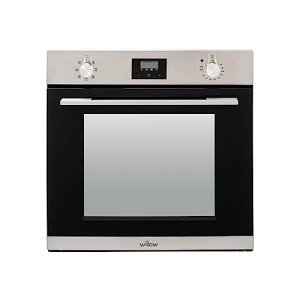Five Killer Quora Answers To Builtin Oven
페이지 정보
본문
The Comprehensive Guide to Built-In Ovens: Features, Benefits, and FAQs
Built-in ovens are a popular choice for contemporary kitchen areas, providing versatility, effectiveness, and a smooth design that incorporates perfectly into cabinets. This post will look into the various aspects of built-in ovens, including their functions, benefits, setup alternatives, upkeep suggestions, and answers to frequently asked concerns.
What is a Built-In Oven?
A built-in oven is designed to be set up within kitchen cabinetry and is offered in numerous setups, such as single or double ovens. Unlike freestanding ovens, built-in models provide a streamlined look and use more flexibility bulit in oven kitchen design. They can be found in integrated electric ovens, gas, and steam choices, accommodating a range of cooking choices.
Features of Built-In Ovens
Built-in ovens are packed with features that boost cooking experiences. Here are a few of the most common features to think about:
| Feature | Description |
|---|---|
| Self-Cleaning | Numerous models include a self-cleaning function that burns residue at high temperatures, streamlining upkeep. |
| Convection Cooking | This function uses a fan to distribute hot air, cooking food more evenly and quickly. |
| Smart Technology | Some ovens come geared up with Wi-Fi connectivity, enabling users to manage the oven from another location by means of smartphone. |
| Several Cooking Modes | Include options such as baking, broiling, roasting, and air frying, providing versatility for various dishes. |
| Temperature level Probe | Keeps track of the internal temperature level of food, guaranteeing completely prepared meals whenever. |
| Sleek Design Options | Offered in various finishes (stainless-steel, black, white) to match kitchen decoration. |
Benefits of Built-In Ovens
The installation of a built-in oven brings various benefits to any kitchen:
- Space Efficiency: Built-in ovens optimize kitchen space, supplying a tidy and organized look without compromising performance.
- Improved Cooking Performance: With sophisticated features like convection cooking and accurate temperature controls, built-in ovens typically outperform standard models.
- Style Flexibility: These ovens can be set up at eye level, permitting easy access without flexing down, which can be specifically beneficial for individuals with physical constraints.
- Improved Resale Value: A well-designed kitchen with high-quality built-in appliances might appeal to potential buyers, improving overall residential or commercial property worth.
- Personalization Options: Many brands offer personalized designs that fit the particular measurements and visual of specific kitchen areas.
Setup Options
When picking a built-in oven, understanding the setup choices is crucial. Here are the most typical setups:
Single Built-In Oven: Ideal for smaller sized cooking areas, these units use enough space to prepare a variety of dishes simultaneously, ideal for Builtin Oven daily cooking.
Double Built-In Oven: Best matched for devoted cooks and large families, double ovens enable for simultaneous cooking at two different temperature levels, suitable for meals that require varied cooking techniques.
Combination Steam and Oven: A hybrid service that integrates the advantages of conventional baking with steam cooking. This choice is exceptional for retaining moisture in foods, making it best for baking bread or roasting meats.
Maintenance Tips for Built-In Ovens
Keeping a built-in oven is necessary for its longevity and optimum performance. Here are some practical maintenance suggestions:
Regular Cleaning: Use the self-cleaning feature when needed, and wipe down the outside and interior surface areas routinely to prevent grease buildup.
Inspect the Seals: Inspect the oven door seals for any wear or damage to make sure correct insulation and cooking effectiveness.
Temperature Calibration: Occasionally evaluate the temperature accuracy using an oven thermometer, especially if cooking times seem longer than normal.
Ventilation: Ensure appropriate ventilation around the oven to prevent getting too hot, specifically for built-in designs that might be surrounded by cabinetry.
Frequently Asked Questions About Built-In Ovens
1. Are built in ovens-in ovens more expensive than freestanding models?Yes, built-in ovens tend to be more pricey due to their style, setup requirements, and additional functions. Nevertheless, their benefits can validate the expense in the long run.
2. Can you set up a built-in oven yourself?While some handy people might try to install a built-in oven, it is advised to hire an expert to guarantee proper setup, ventilation, and security standards.
3. What is the average life expectancy of a built-in oven?The common life expectancy of a built-in oven built in is around 10 to 15 years, depending upon usage and maintenance. Regular care can help extend its longevity.
4. Are built-in ovens energy effective?Numerous modern built-in ovens are created with energy effectiveness in mind, incorporating features like insulation and precise temperature controls that may decrease energy consumption compared to older models.

5. Can a built-in builtin Oven [e1adphegqz7e.рф] be fixed if it breaks?Yes, Builtin Oven built-in ovens can often be fixed. It is recommended to call a qualified service technician for medical diagnoses and repair work to guarantee safety and compliance with warranty agreements.
Built-in ovens are an outstanding addition to any modern kitchen, offering a mix of style, performance, and advanced cooking functions. With the ideal knowledge about their features, advantages, and upkeep, house owners can make educated options to boost their cooking experiences. As kitchen style trends continue to progress, the built-in oven stays a staple for those wanting to blend aesthetics with effectiveness in their cooking spaces.
-
- 이전글
- What's Holding Back This Island Hood Industry?
- 25.05.19
-
- 다음글
- 7 Things You'd Never Know About Top Electric Treadmills
- 25.05.19